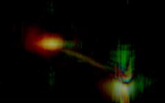Radar images provide difficult images to interpret. Signal returns are rendered showing a one dimensional object that is difficult to interpret. Improving the return image to a more realistic representation of the actual object can greatly improve the operators understanding of the return signal. This can make searches faster and less expensive for almost any use of radar.
This technology uses three different frequency bands to create intensity maps of returned signals. Signals have traditionally been displayed as raw return data. The intensity of the return is represented by level of brightness. Assignment of a scalar value for intensity is used to determine the brightness of the image. In this technology, each frequency is given a designated primary color. The intensity of the signal is mapped onto a grid within a volume in the field of view. Rendering vector images requires multiple numerical values for each voxel/pixel that can be interpreted on a two-dimensional display. If the vector for each voxel has three components it is possible to create color images. Utilizing multiple frequencies enables exploitation of more complex return data enabling truer representation. Mapping of frequency to color helps the operator distinguish the objects.
Traditional image representation produced grey scale images that are difficult to interpret. Triband Image Rendering enables clearer and more realistic visual representation. This allows the analyst to have a clearer picture of what has been detected, thus improving identifications, which then enhances their response time and decision making.
Viewing Ground Penetrating Signals for
- Construction subsurface mapping
- Buried Explosives
- Buried Human Remains
- General GPR searches.
- Forensic & Law Enforcement
- Mining & Quarrying
- Military
- Agriculture & Forestry
- Concrete Scanning & Assessment
- Mapping Roads & Bridges
- Utility Locating
Current stage of technology development: TRL 9
US Patent Application No. 20240221225 COLOR IMAGE RENDERING FOR GROUND-PENETRATING RADAR SYSTEMS published 07/04/2024



